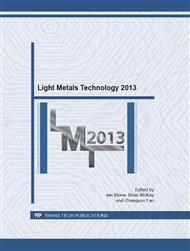p.54
p.59
p.64
p.69
p.77
p.82
p.87
p.92
p.97
Improvement of the Interdependence Analytical Model through Selection of Interfacial Growth Rates during the Initial Transient
Abstract:
The Interdependence Theory is based on the concept that grain refinement of an alloy during the initial transient of solidification is governed by the simultaneous occurrence of growth of an already nucleated grain and the associated Constitutional Supercooling (CS) developing ahead of the growing grain. Nucleation of a new grain occurs when the maximum CS attained at the end of the diffusion field of the solute rejected in front of the growing grain, is larger than the nucleation undercooling DTn of an inoculant particle present ahead of this point. The amount of grain growth plus the length of the diffusion field constitute the Nucleation-Free Zone (NFZ). The mathematical form of this theory is an analytical model which has been shown to be sensitive to the value of the growth rate v of the solid-liquid interface chosen to predict the as-cast grain size. This work presents the development and application of a varying growth rate expression rather than a constant growth rate used in the analytical model to improve its agreement with mMatIC, a numerical model of solidification which has been shown to effectively model grain growth and the evolution of the diffusion field. The possible range of values of growth rate that occurs during initial growth of a grain is obtained from numerical simulations. The resulting modified analytical model is compared against the numerical model for assessing the extent of NFZ formed.
Info:
Periodical:
Pages:
77-81
Citation:
Online since:
July 2013
Authors:
Price:
Сopyright:
© 2013 Trans Tech Publications Ltd. All Rights Reserved
Share:
Citation:


